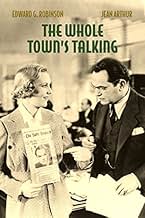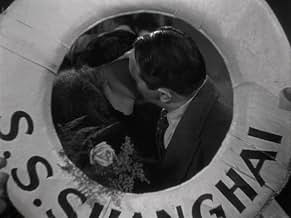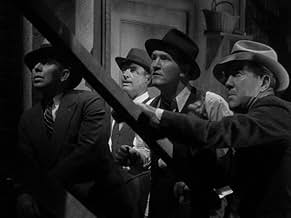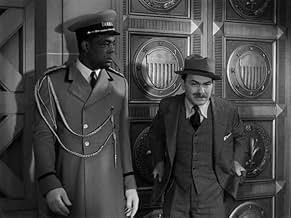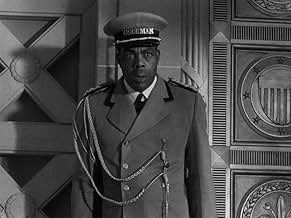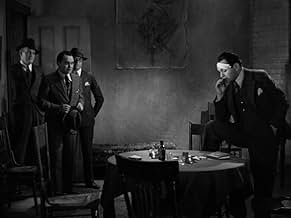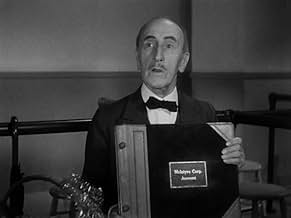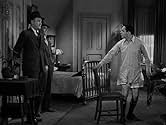NOTE IMDb
7,3/10
3,6 k
MA NOTE
Ajouter une intrigue dans votre langueA meek milquetoast clerk is mistaken for public enemy N° 1, and the notorious killer takes advantage of the situation.A meek milquetoast clerk is mistaken for public enemy N° 1, and the notorious killer takes advantage of the situation.A meek milquetoast clerk is mistaken for public enemy N° 1, and the notorious killer takes advantage of the situation.
- Réalisation
- Scénario
- Casting principal
Harry Abrahams
- Convict
- (non crédité)
Ernie Adams
- Reporter
- (non crédité)
Carmen Andre
- Clerk
- (non crédité)
Chester A. Bachman
- Policeman
- (non crédité)
Eddie Baker
- Policeman
- (non crédité)
Lucille Ball
- Bank Employee
- (non crédité)
H. Barnum
- Undetermined Secondary Role
- (non crédité)
George Barton
- Policeman
- (non crédité)
Avis à la une
John Ford directs a screwball comedy?? He does and quite well I may say. This is a story of a meek mild manner clerk named Ferguson(Robinson) who always gets stepped on and used. One day he is mistaken for "Killer Mannion". Mannion is a mean ruthless gangster who cares for no one. Ferguson is a sweet kind man who cares for beautiful Wilhelmina(played by Jean Arthur). Thanks to a police screwup, Mannion knows about Ferguson and is out to use him.
The script is cute and funny. It's also good in setting up the situation and the development of characters. It is not one of the best comedy ever made, but it is still very entertaining. The cast is first rate. Edward G does a terrific job at playing both the good AND the bad guy. Jean Arthur is funny as Eddie's wise cracking co-worker(check her out playing the "gangster moll"!) The other supporting characters are good too. The special effects showing both Robinsons on screen is quite good for it being 1935.
If you get a chance to see it, please do. It is a very cute film.
The script is cute and funny. It's also good in setting up the situation and the development of characters. It is not one of the best comedy ever made, but it is still very entertaining. The cast is first rate. Edward G does a terrific job at playing both the good AND the bad guy. Jean Arthur is funny as Eddie's wise cracking co-worker(check her out playing the "gangster moll"!) The other supporting characters are good too. The special effects showing both Robinsons on screen is quite good for it being 1935.
If you get a chance to see it, please do. It is a very cute film.
I saw this movie a long time ago as a teenager during a Edward G. Robinson retrospective. It was the one that stuck in my mind, and I never forgot it. Now I have it on videotape and watch it regularly, it stands multiple viewing very well.
The Whole Town's Talking is one of those perfect little movies. Everything falls into place the acting, the pace, the timing of the jokes, the dialog. Even the set design is fabulous, it was basically the big, bright office space in which the good guy Robinson plays slaves" that was unforgettable to me. The movie boasts an assortment of caricature like characters like no other movie I know, beside Robinson I would like to mention Jean Arthur, of course, and the two funny little guys, Donald Meek and, even more memorable, Etienne Girardot as the pedantic office overseer who urges Robinson to get on with the Macintyre account.
In its social comment The Whole Town's Talking reminds me of the work of Preston Sturgess. Mentionable are the media hype about a famous gangster which is really over the top (it's up there with His Girl Friday in this aspect) and the incompetence of the police force which is unable to deal with the gangster and even less with the media and is presented as a helpless and clueless organization. So the movie still has some actuality.
Movie buffs who look at John Ford as an auteur" may be disappointed. The Whole Town's Talking is very much a product of the studio system. But it amply shows what great things that system was able to accomplish at times!
The Whole Town's Talking is one of those perfect little movies. Everything falls into place the acting, the pace, the timing of the jokes, the dialog. Even the set design is fabulous, it was basically the big, bright office space in which the good guy Robinson plays slaves" that was unforgettable to me. The movie boasts an assortment of caricature like characters like no other movie I know, beside Robinson I would like to mention Jean Arthur, of course, and the two funny little guys, Donald Meek and, even more memorable, Etienne Girardot as the pedantic office overseer who urges Robinson to get on with the Macintyre account.
In its social comment The Whole Town's Talking reminds me of the work of Preston Sturgess. Mentionable are the media hype about a famous gangster which is really over the top (it's up there with His Girl Friday in this aspect) and the incompetence of the police force which is unable to deal with the gangster and even less with the media and is presented as a helpless and clueless organization. So the movie still has some actuality.
Movie buffs who look at John Ford as an auteur" may be disappointed. The Whole Town's Talking is very much a product of the studio system. But it amply shows what great things that system was able to accomplish at times!
Whole Town's Talking, The (1935)
*** (out of 4)
A timid, shy and all around weak store clerk (Edward G. Robinson) gets mistaken for a harden gangster (Robinson) but his new fame allows him to store writing a column in a newspaper about how gangster are weak without their guns. Soon the gangster shows up wanting more than just a little help. As a comedy this movie is a real masterpiece but as a drama, the final thirty-minutes or so really bring down a lot of the great moments. While watching this Columbia movie you can't help but wonder if this was originally meant to be directed by Frank Capra as it has his screenwriters and the small town story certainly seems like something you'd get from a Capra and not someone like Ford. To his credit, Ford does a great job with the comedy and really delivers one of the funniest movies of the 1930's. The problem happens in the third act when it really turns to too much of a gangster film and the laughs are pretty much forgotten. What holds both sides together is the terrific performance by Robinson. The way he plays the timid clerk is just downright hilarious and this includes a masterfully acted interrogation sequence where Robinson is nearly brought to tears because he's so scared. Seeing a tough guy like Robinson acting scared was just hilarious and one actually starts to feel sorry for the guy because it appears he's about to die. Robinson is also great in his second role as the gangster as he's as tough as ever and does manage to come off quite demanding and threatening. Jean Arthur is wonderful as well and adds many great comic scenes including her own interrogation where she keeps admitting to crimes that she has nothing to do with or even knows about. Arthur Hohl, Arthur Byron, Wallace Ford and Donald Meek round out the supporting cast. You can even see Joe Sawyer playing one of Robinson's goons. Again, I didn't care for the final act of the film as the comedy starts to not happen but that doesn't take away from everything at the start of the movie. Robinson has never gotten the credit he deserves as an actual actor, which is a real shame but this film allows for both sides of him to be highlighted and to great effect.
*** (out of 4)
A timid, shy and all around weak store clerk (Edward G. Robinson) gets mistaken for a harden gangster (Robinson) but his new fame allows him to store writing a column in a newspaper about how gangster are weak without their guns. Soon the gangster shows up wanting more than just a little help. As a comedy this movie is a real masterpiece but as a drama, the final thirty-minutes or so really bring down a lot of the great moments. While watching this Columbia movie you can't help but wonder if this was originally meant to be directed by Frank Capra as it has his screenwriters and the small town story certainly seems like something you'd get from a Capra and not someone like Ford. To his credit, Ford does a great job with the comedy and really delivers one of the funniest movies of the 1930's. The problem happens in the third act when it really turns to too much of a gangster film and the laughs are pretty much forgotten. What holds both sides together is the terrific performance by Robinson. The way he plays the timid clerk is just downright hilarious and this includes a masterfully acted interrogation sequence where Robinson is nearly brought to tears because he's so scared. Seeing a tough guy like Robinson acting scared was just hilarious and one actually starts to feel sorry for the guy because it appears he's about to die. Robinson is also great in his second role as the gangster as he's as tough as ever and does manage to come off quite demanding and threatening. Jean Arthur is wonderful as well and adds many great comic scenes including her own interrogation where she keeps admitting to crimes that she has nothing to do with or even knows about. Arthur Hohl, Arthur Byron, Wallace Ford and Donald Meek round out the supporting cast. You can even see Joe Sawyer playing one of Robinson's goons. Again, I didn't care for the final act of the film as the comedy starts to not happen but that doesn't take away from everything at the start of the movie. Robinson has never gotten the credit he deserves as an actual actor, which is a real shame but this film allows for both sides of him to be highlighted and to great effect.
Enjoyed this 1935 Classic in which Edward G. Robinson plays a duel role as Arthur Ferguson, (Jonesy) and Killer Mannion. Arthur Ferguson is an ordinary law abiding citizen and is rather a very meek person. Unfortunately, Ferguson looks just like a gangster named Killer Mannion who is a harden criminal and they both seem to have the same facial appearance. Jean Arthur, (Wilhelmina Clark) gives a great supporting role along with a great cast of veteran actors. There is a split screen between Arthur Ferguson and Killer Mannion and Edward G. Robinson gives an outstanding performance in 1935 which was not seen very often in films during those days. Killer Mannion tries to murder Ferguson in a bank hold up but things get out of hand. There is plenty of drama and comedy. This is truly a great Classic Film. Enjoy
This is an atypical and impersonal Ford film. Given the studio (Columbia Pictures) and the screenwriter (Robert Riskin), this is an ideal stuff for Frank Capra. But it remains without a doubt one of the most enjoyable and pleasurable comedies ever made. It features graceful dynamism and vibrancy that are rare in the Ford oeuvre. It is also one of his fastest movies. It contains what it is probably one of the finest Edward G. Robinson performances I have seen. He is outstanding in the dual role of a mild, working class office clerk Arthur Ferguson Jones who is mistaken for a ruthless mobster Mannion (the role he perfected in "Little Caesar"). And then there is the lovely Jean Arthur as Robinson's coolly self-reliant co-worker, who starts by pitying him and then encourages him, and ultimately falls in love with him. She and Robinson are superb together. It is nowhere near her splendid presence in Mitchell Leisen's "Easy Living" and Frank Borzage's "History Is Made at Night", but this was the sort of role Arthur was to make of her own.
A must-see!
A must-see!
Le saviez-vous
- AnecdotesThe $250.00 per week that Jones is to get for writing the article in this 1935 comedy translates to $4,999.23 per week in 2019 dollars.
- GaffesWhen Jonesy leaves his apartment in a rush he forgets to turn off the taps and his tub is (torrentially) overflowing. But when he returns from the police much later in the day there is no water anywhere.
- Citations
Arthur Ferguson Jones: You know something, a woman is only a woman, but a good cigar is a smoke.
- ConnexionsEdited into Michael Jackson's This Is It (2009)
Meilleurs choix
Connectez-vous pour évaluer et suivre la liste de favoris afin de recevoir des recommandations personnalisées
- How long is The Whole Town's Talking?Alimenté par Alexa
Détails
- Durée
- 1h 33min(93 min)
- Couleur
- Rapport de forme
- 1.37 : 1
Contribuer à cette page
Suggérer une modification ou ajouter du contenu manquant


